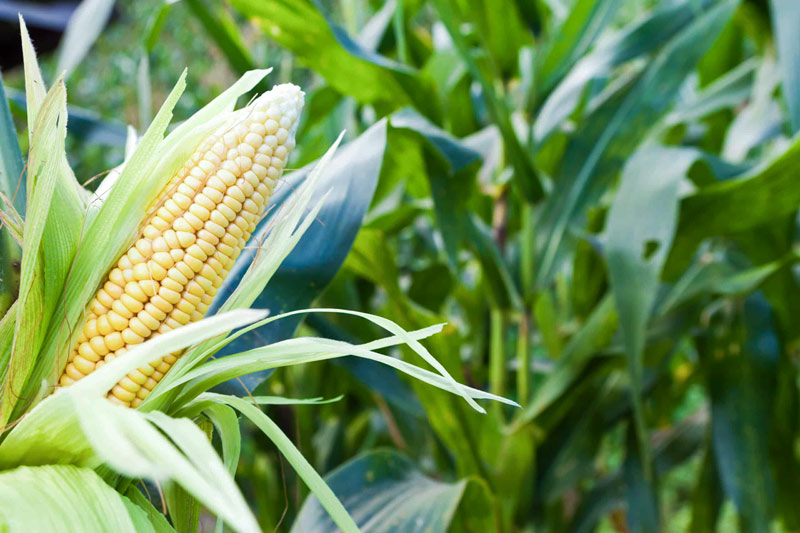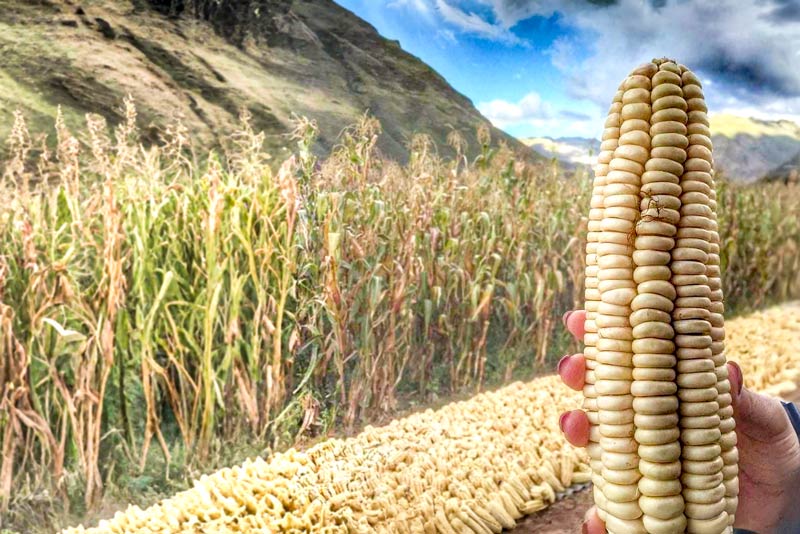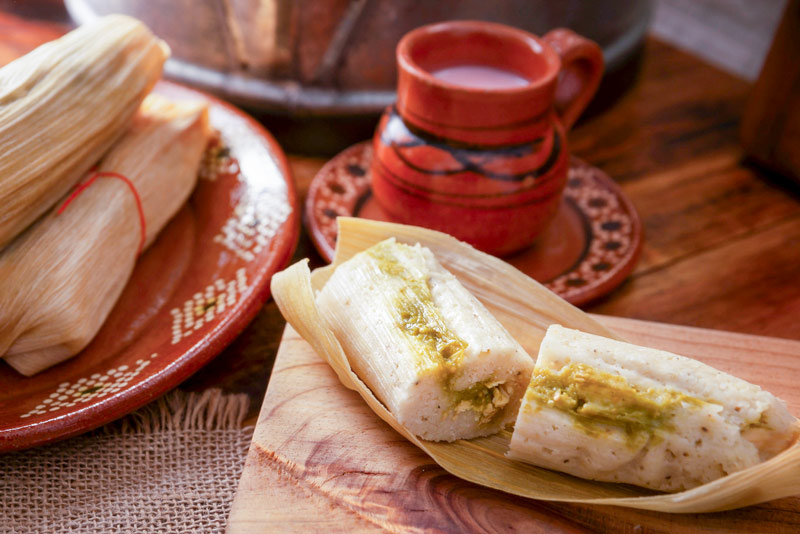Cusco’s giant corn in the Sacred Valley of the Incas
Very few people know this, but it’s a secret that should be shared. Giant white corn grows in the Sacred Valley, an impressive agricultural product that allowed the Incas to begin their expansion and found their empire, thanks to its nutritional value and fertility in the valley’s lands. Today, its value is just as important, remaining a part of the traditional diet and a fundamental part of Andean culture. Learn more about Cusco’s giant corn, the tour you can take to learn about it, and the dishes you must try featuring this incredible product.
- Origin and importance of corn for Andean culture
- Characteristics of giant corn from Cusco
- Gastronomy with giant corn
- Tours to discover giant corn
- Tips and recommendations
- Frequently Asked Questions
Origin and importance of corn for Andean culture
There is a legend that tells of the god Pacha Kamaq – the giver of life (a deity of the Lima, Ichma, and Wari cultures, and later highly respected by the Incas due to his similarity to the god Viracocha) who created giant corn from a child’s teeth to feed his people. It is a story that links this corn to its power of fertility and the abundance it brought to the Incan culture. Discover the Incas’ relationship with nature.
Today, its importance in Andean culture is equally significant, given that in the Urubamba and Calca valleys it covers approximately 90% of the cultivated area, although it is also very present in towns such as San Salvador, Huayllabamba, Yucay, Taray, Coya, Ollantaytambo, and Lamay. All of these towns belong to the Sacred Valley.
In addition, it has great nutritional value, since it is rich in complex carbohydrates, fiber, proteins and is low in fat, ideal for obtaining energy and to implement it in any diet, since it is a light food with a great, slightly sweet flavor.
Sacred Valley of the Incas Tour:
Discover the giant white corn of Cusco on a tour of the Sacred Valley of the Incas, where you can glimpse the agricultural fields and stop to appreciate their majesty. This tour will also visit Pisac, Ollantaytambo, and Chinchero, providing a complete experience of the valley’s most iconic sites. Lunch in Urubamba is also included. Book the tour with us and don’t miss the opportunity to discover the giant white corn of Cusco.
Characteristics of giant corn from Cusco
Giant white corn is the most planted and harvested product in the Sacred Valley. It is grown only in this magical territory, which boasts the ideal conditions for corn to grow into the most prized product. Discover its most important characteristics and what makes it so prized:
| Characteristics of giant corn | |
|---|---|
| Location | In the Urubamba and Calca valleys, representing more than 90% of the cultivated area. |
| Height | Between 2,750 and 2,950 meters above sea level. |
| Aspect | White corn with large grains. |
| Size | Up to 2 or 3 times larger than conventional corn. |
| Texture | Soft, floury and slightly sweet. |
| Cultural importance | The main food produced, it is also considered a symbol of fertility, formerly used in religious ceremonies. |
| Nutritional value | Rich in complex carbohydrates, fiber, protein, and low in fat, ideal for energy. |
| Harvest season | In the month of June and its growth and maturity time is 240 to 270 days. |
Gastronomy with giant corn
The culinary diversity of Peru and Cusco is among the richest in the world. Many of their dishes feature corn as their main ingredient, which lends a more authentic experience and, thanks to its nutritional value, complements any diet. Discover the main dishes and some drinks in which you can try Cusco’s giant corn.
- Choclo con queso (choclo with cheese), a must-have on any cold day, can be found throughout the region as it is the most popular way to eat giant Cusco corn, and cheese is its star accompaniment.
- Solterito con choclo is a salad with corn kernels, beans, cheese, onion, and tomato. Corn is the base ingredient and adds sweetness to the dish.
- Chicha de jora, a fermented beverage made from germinated dried corn (jora). It is the region’s most typical beverage and is consumed at celebrations and also used as an offering.
- White corn humitas are a ground corn dough, wrapped in corn leaves and steamed, they can be sweet or salty.
- Cusco tamales, similar to humitas, are made with ground corn, filled with meat, chili or olives, wrapped in corn leaves and steamed.
- Corn tortilla, prepared with ground or shelled corn, is present in many breakfasts and can be accompanied with many foods.
- Chicharrón with corn, the giant white corn provides sweetness and balances the fat of the chicharrón.
- Corn soup, made with giant corn kernels, potatoes, cheese, and herbs like huacatay or cilantro. It’s light yet energizing.
- Pumpkin locro is a thick stew made with pumpkin, potatoes, and shelled corn. The giant corn adds texture and a slightly sweet flavor.
- Maná is a sweet, floury type of corn made from white corn that has been dried, toasted, and finely ground. Its texture is soft and sandy.
- Mote is boiled corn that can accompany any meal, ideal as an appetizer or snack.
Tours to discover giant corn
The Sacred Valley of the Incas is home to this giant white corn. Throughout its entire length and in each of its villages, we can see examples of its magnificence, especially during the harvest season in June. If you want to learn about this magical product, we’ll show you the best tours you can take. This way, you can also venture to the main Inca citadels and discover the traditions of Andean culture.
Classic tour of the Sacred Valley
The classic Sacred Valley experience takes us through the most important Inca citadels, such as the Pisac archaeological site and its traditional market, the Ollantaytambo archaeological fortress, and the Chinchero Archaeological Park. It’s an immersive tour that also includes a stop in Urubamba for lunch and a taste of the famous giant corn. Throughout the tour, we’ll be able to see the corn fields, which add even more beauty to the landscape.
VIP Tour of the Sacred Valley
Similar to the classic tour, but with the addition of two star destinations: the Maras salt mines and the circular terraces of Moray. This experience also lasts a full day, allowing you to explore a larger area of the Sacred Valley, experiencing how giant white corn is grown throughout its length. During the lunch stop in Urubamba, you can try it. During the tour, we’ll also find places that sell choclo con queso (corn with cheese), which is the best way to try this incredible product.
Travel on my own
If your mission in the Sacred Valley is simply to discover giant white corn, choosing to travel on your own will give you much more time to stop and discover more recipes. The main towns are Urubamba, Calca, and Pisac, where you can enjoy a leisurely tour sampling the cuisine. In any of the valley’s towns, this will greatly enrich your Cusco travel experience.
Tips and recommendations
To help you enjoy a more informed trip to Cusco’s giant corn in the Sacred Valley, we’ll provide a series of tips and recommendations that will make your trip a more immersive and unforgettable experience. Learn the most important points:
- Exploring the Sacred Valley is ideal during your first few days in Cusco. Thanks to its climate, you can acclimatize amidst beautiful landscapes and prevent altitude sickness.
- You can explore the entire valley in a single day, although it’s best to take your time to explore the charm of each of its towns, where you can sample traditional cuisine featuring giant white corn.
- The harvest season for giant white corn is in June, although you can find it year-round without any problems.
- Visiting the Sacred Valley during the dry season (April to October) will allow you to experience it alongside clearer landscapes.
- During the rainy season (November to March) in the Sacred Valley, the weather is likely to be very rainy, but the landscape will be much greener and more flowery.
- The Sacred Valley has an average altitude of 2,900 meters above sea level, a unique geographic location, and an ideal climate that makes it the only territory where giant white corn grows.
- Giant white corn is the most widely cultivated agricultural product in the Sacred Valley, accounting for up to 90% of production in some areas.
- Discover firsthand experiences in local communities in the Sacred Valley to learn more about Andean culture, traditions, and cuisine.
- Take advantage of your trip and relax amidst beautiful landscapes. The agricultural fields add a touch of beauty to the valleys.
- You can plan a tour visiting the agricultural fields of the Sacred Valley by deciding which route to take. Consult with our advisors and discover the surprises that await you.
Frequently Asked Questions
1) What is special about giant corn from Cusco?
Giant Cusco corn is not only larger than regular corn, but it also grows only in the Sacred Valley, thanks to its climate, altitude, and fertile soils. It also has a soft texture and a slightly sweet flavor.
2) Why was corn so important to the Incas?
For the Incas, corn was synonymous with fertility and power. It was their staple food and allowed them to expand their empire thanks to its nutritional value.
3) Where can I see giant corn grow?
Mainly found in the Urubamba and Calca valleys, where it represents more than 90% of the cultivated area. You can also see it in towns like Pisac, Yucay, Ollantaytambo, and Lamay.
4) In what season is giant white corn harvested?
Giant white corn is harvested in June. However, it is available year-round.
5) What dishes should I try with giant corn?
The most traditional is corn with cheese, but solterito with corn, humitas, Cusco tamales, and drinks like chicha de jora are also worth trying.
6) Can I organize my own trip to see giant white corn?
Yes, you can explore towns like Calca, Pisac, and Urubamba on your own, where you’ll find markets, farmland, and local restaurants. This option gives you more freedom to explore the local cuisine.
7) What is the best time to visit the Sacred Valley?
The best time is the dry season, from April to October, when the weather is more stable and the clear skies allow you to appreciate all the landscapes.
8) What nutritional benefits does this corn have?
It’s an excellent source of energy thanks to its complex carbohydrates. It’s also rich in fiber, contains protein, and is low in fat. This makes it a healthy and balanced food for any diet.
9) Is there any difference between this corn and the one I normally know?
Yes, Cusco giant corn can grow up to three times larger than conventional corn. Its texture is flourier and its flavor sweeter. It’s also not found anywhere else in the world due to its unique growing conditions.
10) Can I buy giant corn to take home?
Yes, in many local markets, especially in Urubamba and Pisac, you can find dried corn or mote to take away. Some stands even sell humitas or tamales.
Advice from people who have been there
 By: Leslie U.
By: Leslie U.“A mandatory stop in Urubamba“
“During my visit to the Sacred Valley, one of the best moments was tasting the corn with cheese in a small market in Urubamba. The taste of the corn is really different, sweeter and milder. I went in June, right in harvest time, and the fields were beautiful. I recommend taking time to walk around the villages calmly, because in each one there is something special.“
By Ticket Machu Picchu – Last updated, July 16, 2025


